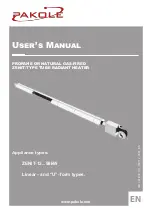
SmartPlate Installation, Operation & Maintenance Manual
CHAPTER 7
– TROUBLESHOOTING
OMM-0069_0H
• SP-100 • 1/30/2020 Technical Support • (800) 526-0288 • Mon-Fri, 8 am - 5 pm EST Page
54
of
134
TABLE 7-3. Troubleshooting Guide for Temperature Control Issues
No.
Observation
Probable Cause
Corrective Action
T9-1
Too much valve
oscillations or too wide
outlet temperature
oscillation at low flow
Low flow condition may
be unsteady or at a
critical value for the
control system.
Increase the Proportional value (Pb
and/or Pb2). Note: This may cause
wider temperature deviation with
change in domestic flow.
T9-2
Too wide a deviation in
outlet temperature when
domestic flow changes
Dynamic loop response
time variation from the
engineering development
system. Many factors
contribute to this type of
dynamic system
variation.
Decrease the Proportional value (Pb
and/or Pb2) and/or decrease
FeedForward (FFpb).
Note 1:
This may increase
oscillations at low flow.
Note 2:
A change in FFpb will cause
the valve to fully open initially and
over temperature may occur. Be
sure the domestic outlet is shut to
prevent scalding.
T9-3
On decrease in flow,
outlet temperature
initially goes up but
then under-shoots
setpoint too much
before coming to
setpoint
Dynamic loop response
time variation from the
engineering development
system. Many factors
contribute to this type of
dynamic system
variation.
Increase Proportional (Pb or Pb2)
first. If that has little or no effect then
increase FeedForward (FFpb.
Note:
A change in FFpb will cause
the valve to fully open initially and
over temperature may occur. Be
sure the domestic outlet is shut to
prevent scalding.
T9-4
On increase in flow,
outlet temperature
initially goes down but
then overshoots setpoint
too much before coming
to setpoint
Dynamic loop response
time variation from the
engineering development
system. Many factors
contribute to this type of
dynamic system
variation.
Increase Proportional (Pb or Pb2)
first. If that has little or no effect then
increase FeedForward (FFpb).
Note:
A change in FFpb will cause
the valve to fully open initially and
over temperature may occur. Be
sure the domestic outlet is closed to
prevent scalding.
T9-5
After a change in
domestic flow, outlet
temperature remains too
far from setpoint for too
long
Dynamic loop response
time variation from the
engineering development
system. Many factors
contribute to this type of
dynamic system
variation.
Decrease Proportional and/or
decrease Integral (I1 and/or I2).
Note:
This may increase outlet
temperature oscillations at lower
flows.
T9-6
Over-temperature alarm
or water temperature
more than 10°F above
the setpoint after a long
period of non-usage.
Control valve not closing
fully, allowing some hot
boiler water to enter the
heat exchanger without
demand
Recalibrate the valve stroke using
the auto-calibration method
described in Chapter 4, section
4.2.1.
















































